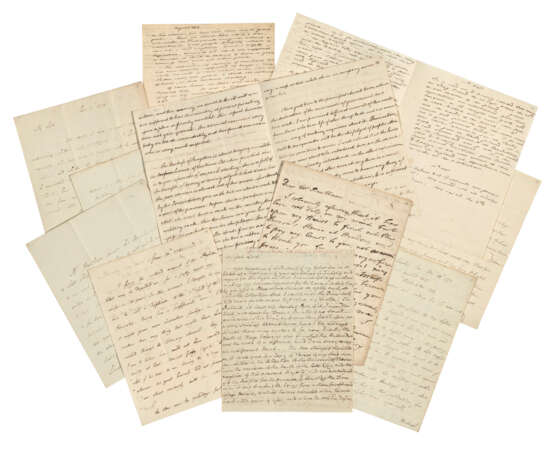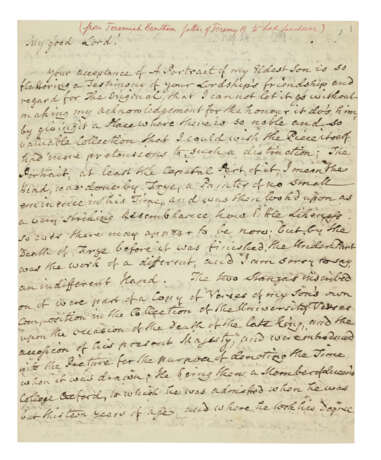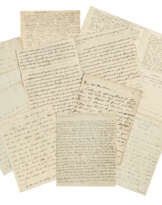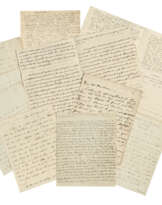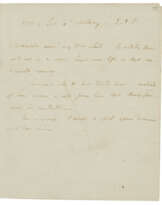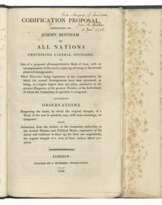ID 1109074
Lot 274 | Jeremy Bentham (1748-1832) and Jeremiah Bentham (1712-1792)
Estimate value
£ 7 000 – 10 000
Autograph letters to the 1st Marquess of Lansdowne, 1778-1784
Jeremy Bentham. 5 autograph letters and autograph copies of reports sent to him by his brother Samuel, addressed to [William Petty], 2nd Earl of Shelburne [later 1st Marquess Lansdowne], chiefly Lincoln's Inn, 17 September 1779-10 June 1780. 11 pages. [With:] a four-page scribal copy of a report with 9-line autograph addition. Provenance: Marquesses of Lansdowne; their sale, Christie’s, Bowood House sale, 12 October 1994, lot 1.
These letters appear to be the earliest communications from Bentham to the Earl of Shelburne (later the 1st Marquess of Lansdowne), his close friend and patron. The letters comprise: (1) 17 September 1779 (4 pages, signed): informing Lord Shelburne of news with extracts from his brother’s letter from Amsterdam; (2) 18 November 1779 (4 pages): report of news from Hamburg; (3) 10 June 1779 (6 pages): account of the Russian fleet, as sent from St Petersburg by his brother Samuel, with scribal copy of the account; (4) May/June 1780 (one page): extract from a letter from Samuel from St Petersburg regarding the Swedish fleet; (5) [July 1780] (one page): Bentham regrets he cannot take up Lord Shelburne’s invitation as he is about to leave London; with a half-page autograph fragment and two scribal copies of reports from Samuel Bentham. [Also with:] William Petty, 1st Marquess Lansdowne. Autograph letter signed to Jeremy Bentham, Lansdown House, [16 June 1788], 4 pages: ‘to tell you how much we wish to see you at Bowood’, and that ‘The accounts from France are wonderfully serious. Sanguine people imagine a civil war must ensue’.
The young Jeremy Bentham was devoted to his brother Samuel, who shared his numerous interests and a common temperament. After their shared schemes and proposals failed to gain ground in Britain in the late 1770s, the brothers came to believe that in Russia their talents would not go unrecognised, with Bentham hoping that his special gifts for legislation and codification might be noticed by the Empress Catherine II and her circle. The brothers began to cultivate every friend and acquaintance connected with Russia; they won references from men of status including William Petty, Earl of Shelburne (created marquess of Lansdowne in 1784), to whom Samuel was introduced through Bentham's legal acquaintance, the exchequer judge Francis Maseres. This contact was to bear fruit for both brothers, and Bentham kept Shelburne informed of Samuel's activities by sending him excerpts from Samuel's letters. Samuel left Britain in August 1779 to begin an odyssey in Russia which lasted for nearly twelve years until his return in May 1791.
[and:]
Jeremiah Bentham. Autograph letter signed (‘Jere:h Bentham’) to [William Petty, 1st Marquess of Lansdowne] (‘My good Lord’), St James’ Park, 24 November 1789. 3 pages, 229 x 184mm, bifolium. Provenance: Marquesses of Lansdowne; their sale, Christie’s, Bowood House sale, 12 October 1994, lot 8.
On his gift of a portrait of his son, Jeremy, aged 14, to Lord Shelburne; the painting in question is now at the National Portrait Gallery (NPG 196). ‘Your acceptance of a Portrait of my Eldest Son is so flattering a Testimony of your Lordship’s friendship and regard for the Original […], going on to tell him that the portrait was drawn after he had entered Oxford University at the age of 13, that he took his degree aged 16 and his Master’s degree aged 20. ‘he became the youngest graduate that had ever been in the regular Course of Education at either of our Universities’. He explains the presence of a violin in the painting by recounting that Jeremy had been able to play the instrument at the age of five, and at the same age he had already shown interest in philosophy’.
| Artist: | Jeremy Bentham (1748 - 1832) |
|---|---|
| Place of origin: | England |
| Artist: | Jeremy Bentham (1748 - 1832) |
|---|---|
| Place of origin: | England |
| Address of auction |
CHRISTIE'S 8 King Street, St. James's SW1Y 6QT London United Kingdom | |||||
|---|---|---|---|---|---|---|
| Preview |
| |||||
| Phone | +44 (0)20 7839 9060 | |||||
| Buyer Premium | see on Website | |||||
| Conditions of purchase | Conditions of purchase |
